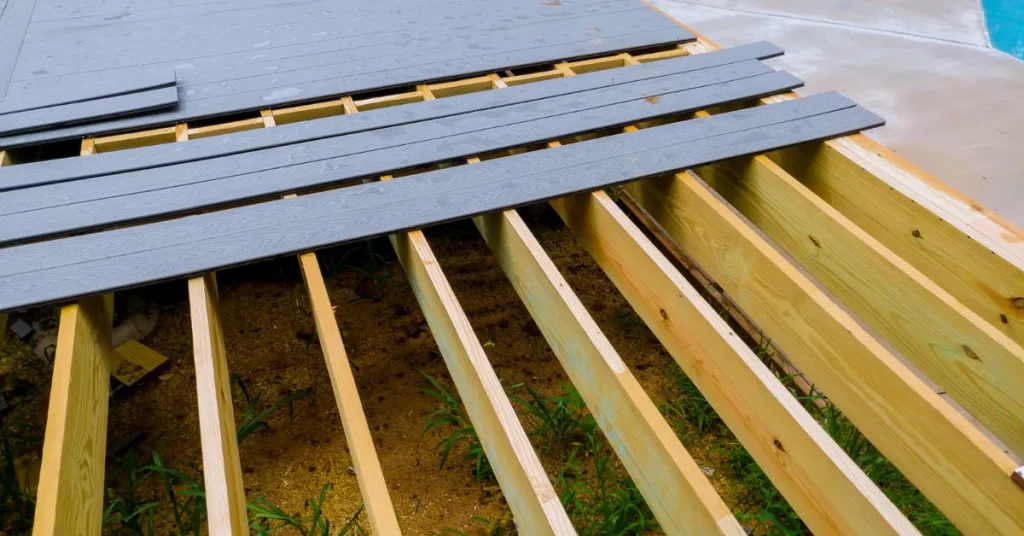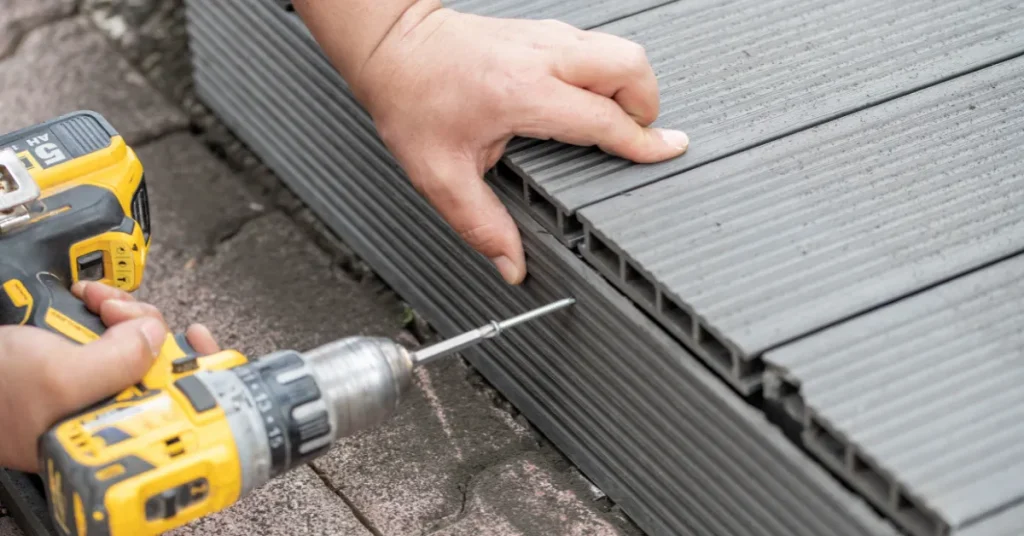Composite decking typically ranges from about 0.9 inches to 1.1 inches in thickness. The exact measurement can vary by brand and product line.
Choosing the right decking for your outdoor space is important for both aesthetics and durability.
Composite decking offers a blend of beauty and maintenance-free longevity, making it a favorite among homeowners.
As it combines plastic and wood fibers, this eco-friendly option stands strong against the elements and resists rot and pest damage.
Its thickness contributes to the deck’s strength and ability to withstand foot traffic and furniture weight.
A proper understanding of composite decking’s dimensions ensures that your deck design will meet both your functional requirements and visual preferences, leading to a comfortable, inviting outdoor living area.

Composite Decking Thickness Basics
Welcome to the world of composite decking, a durable and low-maintenance option for outdoor living spaces. Understanding composite decking thickness basics is crucial for anyone planning their dream deck. Thickness impacts both the performance and the aesthetic of your deck, so let’s dive into the specifics.
Standard Measurements
Most composite decking comes in a range of standard thickness measurements to suit various needs. The typical thickness for residential composite decks is:
- 1 inch (25.4 mm) – Common for residential projects.
- 5/4 inch (31.75 mm) – Offers more strength for high-traffic areas.
These measurements ensure stability and durability for everyday use. Specific dimensions cater to unique design or structural requirements.
A table highlighting standard thickness sizes can provide a quick reference:
| Decking Type | Thickness |
| Residential Standard | 1 inch (25.4 mm) |
| Enhanced Strength | 5/4 inch (31.75 mm) |
Variations Among Brands
Different brands offer unique thickness options. This diversity caters to varied consumer needs. Here are examples of how thickness can vary:
- Extra-thick boards for commercial use.
- Thinner boards for cost-effectiveness.
- Profiles with scalloped bottoms to reduce weight.
It is essential to check the specifications of each brand. Even slight variations in thickness can affect installation and long-term usability. Prioritize known brands with consistent quality for the best results.
Factors Influencing Thickness Choices

When choosing composite decking, thickness is a key factor. It affects durability and performance over time. Homeowners must consider several aspects to decide on the right thickness for their decking project.
Load Capacity And Durability
The thickness of composite decking directly influences its ability to withstand weight and daily wear. A thicker board generally offers better load capacity. This means it can support more weight without bending or breaking.
Different thicknesses serve various functions:
- Standard residential decks often use boards around 25mm thick.
- High-traffic areas might need thicker, more robust boards.
Thicker boards also tend to last longer. They resist damage from foot traffic, furniture, and environmental factors better.
Environmental Considerations
Environmental conditions play a pivotal role in choosing decking thickness. Extremes in temperature and exposure to moisture can impact the longevity of a deck.
| Environment | Suggested Thickness |
| High Humidity | Thicker for longer life |
| Freeze-Thaw Cycles | Thicker to prevent cracking |
| Direct Sunlight | Thicker for reduced warping |
Areas prone to harsh weather may require decking that’s more robust. It should handle the expansion and contraction that comes with temperature swings.
Installation Implications Of Thickness
Understanding the thickness of composite decking is crucial before installation. It influences not only the durability and longevity of your deck but also the installation process.
Let’s explore how the thickness of composite decking can affect the installation.
Substructure Requirements
The substructure is the deck’s foundation. Its design depends on the thickness of the decking boards.
- Joist spacing must be adjusted for board thickness.
- Heavier boards often require more support.
- Using thicker decking can add to the deck’s overall strength.
Aesthetic And Functional Impact
The thickness of your composite decking also affects your deck’s look and use.
- Thicker boards provide a solid, high-end appearance.
- They often lead to a smoother walking surface.
- Thermal expansion can vary with board thickness.
| Board Thickness | Impact on Aesthetics | Impact on Function |
| Thin | Flexible look | More affected by temperature |
| Thick | Robust, luxury feel | Improved stability and durability |
Thick Vs. Thin Decking
Choosing the right thickness for composite decking is vital. It affects durability, the feel underfoot, and the appearance of your deck. But what really sets thick decking apart from thin options?
Performance Comparison
Thicker decking often means better performance. A thick board withstands heavy foot traffic gracefully. Here are key points on performance:
- Strength: Thick boards support more weight.
- Stability: Less likely to warp or crack over time.
- Lifespan: Thicker decking tends to last longer.
In contrast, thin decking can be less robust. It may require:
- More joist support to prevent sagging.
- Extra care during installation to avoid damage.
- Consideration for lighter use areas only.
Cost And Value Analysis
Cost is a major factor in the decking decision. Here’s a breakdown:
| Aspect | Thick Decking | Thin Decking |
| Initial Cost | Higher | Lower |
| Long-Term Value | Better investment | May cost more over time |
| Overall Quality | Typically superior | Can vary |
Investing in thick decking can offer long-term savings. It requires less maintenance and replacements. Thin decking, while affordable up front, might lead to more costs down the line.
Expert Recommendations On Decking Thickness

Choosing the perfect composite decking thickness is vital for your outdoor space’s durability and functionality.
Experts in the field offer guidance to help you make an informed choice, ensuring your deck’s longevity and ease of maintenance. Let our deep dive into decking thickness lead you to the ideal solution for your project.
Choosing The Right Thickness For Your Project
Diverse projects call for specific decking thicknesses. Your deck’s purpose is key in this decision. For residential use, a standard thickness might suffice. Yet, high-traffic areas might need thicker boards. Consider the following:
- Location: Weather conditions impact thickness choices.
- Support: The space between joists defines the thickness needed.
- Usage: More use equals the need for thicker decking.
For optimal results, consult a professional when determining the proper thickness for your deck. Their expertise will guide you to the right selection.
Maintenance Tips Based On Thickness
The chosen thickness of your composite decking influences maintenance routines. Generally, a thicker board withstands elements better and offers more stability.
This can lead to longer periods between required maintenance. Utilize these tips to maximize your decking’s life:
| Thickness | Maintenance Tip |
| Standard | Regular cleaning to prevent mold. |
| Thicker | Inspect less frequently, focus on high-use areas. |
Maintain your deck with the right tools: gentle brushes and cleaners designed for composite materials. Remember, the thickness can affect exposure to the elements, so adjust your care accordingly.
Keep decking clean, no matter the thickness, to ensure longevity and beauty. Schedule routine checks and address issues promptly to avoid long-term damage.
FAQs About How Thick Is Composite Decking
What Is The Standard Thickness Of Composite Decking?
The standard thickness for composite decking typically ranges from 25mm to 30mm. This dimension provides a balance of strength and weight for durable outdoor use.
What Is The Actual Thickness Of 5 4 Decking?
The actual thickness of 5/4 decking is approximately 1 inch. This nominal size refers to the board’s dimension before finishing, typically measuring close to its nominal thickness after being planed and smoothed.
How Thick Is Composite Decking In Mm?
Composite decking typically ranges from 25mm to 30mm in thickness. Different manufacturers may offer variations within this range.
What Is The Best Thickness For Deck Boards?
The optimal thickness for deck boards is generally 1 inch (4/4″ nominal) for ideal balance between durability and ease of installation.
Conclusion
Understanding composite decking thickness is crucial for your outdoor project success. Choose wisely based on durability, aesthetics, and load requirements.
As every deck is unique, align material thickness with your design vision and practical needs. Decking success hinges on this balance—ensure your investment stands the test of time.
